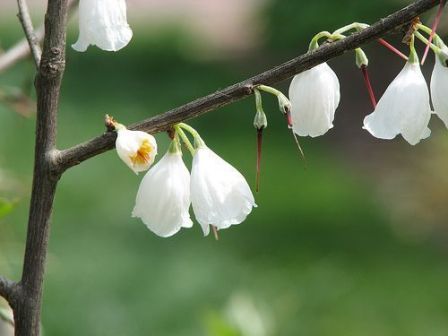Silverbells and Snowdrop Trees The Halesia
Attractive trees from the Halesia species are commonly called Carolina Silverbell, Snowdrop trees or two winged Silverbells. They have a magnificent spring display and are attractive choices for gardens of all sizes. The foliage turns golden yellow in Autumn and the fruit are are bright green maturing too red-brown through Winter. Except as noted below trees seldom exceed 30 feet tall.
Halesia Cultivation.
- All varieties are decidious trees or shrubs that flower in spring prior to leafing. The winged fruit are attractive reasons for growing Halesia.
- Halesia flower more profusely and grow more vigorously if subject to high summer temperatures.
- Halesia may be hard to transplant but small specimens re-establish themselves if planted in late winter or early spring.
- In a natural habitat with broken soil and a cold winter the seeds germinate well.
- Individual stems of H. tetraptera are naturally replaced from new shoots at the base.
- IHalesia prefer an acid soil and like most plants from the Appalachians prefer a moist, well-drained humus rich soil.
- This is a perfect tree for shady corners or set off against a dark background as a specimen tree.
Halesia Species
- Halesia carolina from eastern North America also called H. parviflora Little Silverbell or H. tetraptera the Carolina Silverbell. This is the most freely available in the UK whilst H. parviflora is less known.
- Halesia tetraptera Meehanii is a 10feet high shrub with small but profuse white spring flowers. For larger flowers try Wedding Bells
- H. diptera is thedistinguished from the other Halesia by its two-winged fruit, the other taxa all have four-winged fruit. The variety magniflora has more significantly dramatic blooms prior to leaf formation. If I was choosing just one varoiety this would be my choice.
- Halesia monticola or Mountain Silverbell has specimens up to 100 feet tall known in the Great Smoky Mountains National Park and is the tallest species. The crollas can be 12 inches long and the tree can be used in large landscapes. A pink flowered variety exists Arnold Pink and others are sold as Rosea or Vestita.
- The second-largest is H. macgregorii, reaching 75 feet in Chinese mountains. The others Halesias rarely exceed 10 m tall.
Acknowledgments R Darke and Plantsman RHS. and H G Hillier
